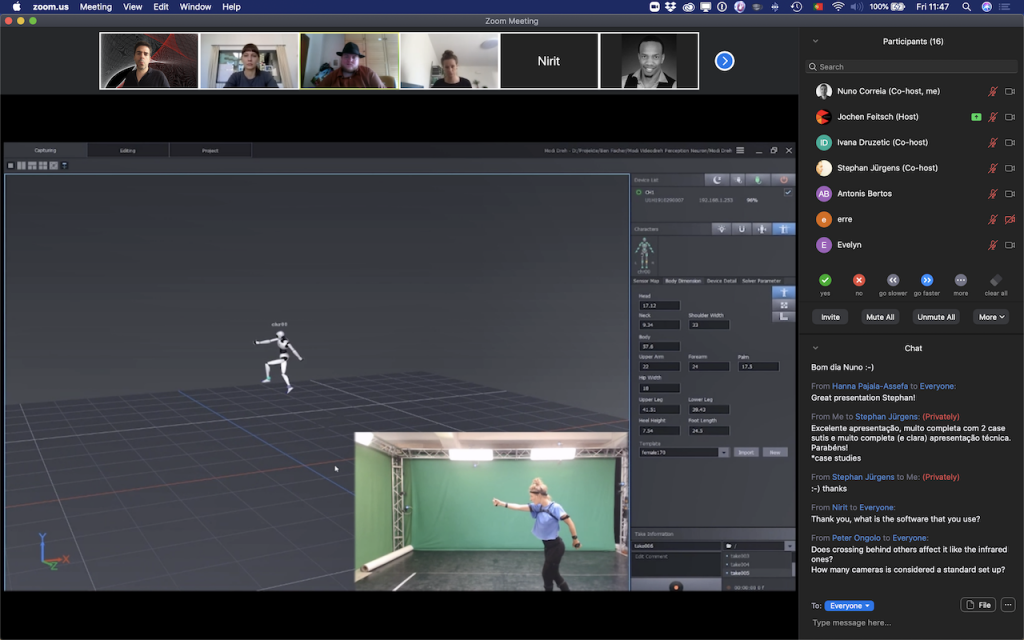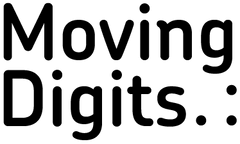Moving Digits Seminar, 25th September 2020
As part of the Moving Digits project, we organized an online seminar (with Zoom) on dance and technology, 25/Sep/2020. Through technical and artistic presentations, the seminar offered an opportunity to discuss important topics related to dance and technology. It also aimed at sharing some key findings and reflections, as the project was coming to an end. It was organized my MIREVI / HSD. Moving Digits is co-funded by the EU Creative Europe programme.
Presentations
Augmenting the Dancing Body and Visualising Choreographic Thinking by Stephan Jürgens
Throughout the Moving Digits project (2019-2020), we have explored several creative ways to make visible what usually is invisible for an audience: for example, what the performer perceives and feels as they are dancing, or what the choreographic ideas behind the scenes look like. In this talk, we will briefly look at different sensor technologies, which were explored by twelve dancers and choreographers from all over Europe during the MODI workshops and performances in collaboration with the technical team. We will present some of the choreographic ideas and how these were put in practice: technical set-up, workflow, potential for improvisation and composition. In this context we will introduce the software Isadora, a user-friendly programming environment, which is commonly used by media artists in theatre productions and interactive installations. Without getting too technical, we will share some solutions developed by the MODI team in response to our performers and choreographers’ ideas, which serve as examples for digital performance ecologies that can be developed “on a budget” – i.e. without needing access to expensive high-end technology.
A Short Introduction to Motion Capture and Showcase of Different Systems by Ben Fischer and Jochen Feitsch with Charlotte Triebus
In the presentation about Motion Capture, the basics and functions of different tracking systems are introduced. The presentation is divided into two parts. In the first section it is clarified what exactly Motion Capture is and in which areas it is used. In addition, it describes which different types of tracking systems exist and then explains their advantages and disadvantages. In the second part the theory from the first section is deepened by practical demonstration of different tracking systems – AzureKinect, CapturyLive, PerceptionNeuron and OptiTrack. The selected systems show a broad spectrum of typical tracking technology and differ in precision, price, technology and system functionality. The strengths and weaknesses of the systems will be discussed in particular. These are illustrated by both showing the software as well as the tracking of a dancer.
Open Sonic Artefact in Dance Performance by Raul Masu
This presentation will focus on third-wave HCI concepts such as ambiguity, appropriation and artefact ecology, applied to interactive sonic systems for dance. The presentation will also analyze how the act of composing and the act of creating new music technology are often overlapped. Primarily, it will discuss the impact of this fact on the design of interactive music for dance. I will start by analyzing ambiguity and appropriation in music, drawing parallels between aleatoric repertoire in the Fifties and Sixties and recent approaches to design digital technology and then see how these approaches influenced the design music technology. I will then focus on the importance of considering the entire ecology when designing interactive sonic artefacts for dance. This will be followed by a description of different models, including ARCAA, a model I developed as part of my research. Finally, I will discuss all these concepts presenting the interactive sonic system developed for one of the performances in Moving Digits.
Shaman, Trance and Mocap by Choy Ka Fai
Technological Flesh is a research and development process of Artist Choy Ka Fai. Inspired by Siberian Shaman going into a trance state, the project investigates the digital possibilities of translating the supernatural dance experience. Can we digitise the dance of the Supernatural? Can we measure the digital notations of trance movement? Technological Flesh proposes new perspectives on how the body can transcend beyond physical boundaries and venture into the digital cosmos of virtual realities. Our choreographic exploration aims to expand the human intellect, physical and psychological capacities in dance. And maybe we all have an itch to transcend beyond our physical flesh.
Acting Spheres by Charlotte Triebus
Spheres (2018-2020) is a choreographic installation at the intersection of intimacy, communication and artificial intelligence, which allows three performers, twelve intelligent spheres and visitors to interact in a museum space. The focus is on communication between people and technology as well as the question of how movement in different bodies can be transformed through interaction, approach and chance.
During the performance, the dancers interact with the spheres for 30 minutes by means of movements and positioning. The intelligent objects not only recognize the performer’s intention (and react to it), but also learn to communicate with the performers over the course of time. The result is a vivid and exploratory study of encounter, communication and agency. In cooperation with Mirevi, Hochschule Düsseldorf and Tennagels.
Spheres is a process. The current status of the work was presented in the past at several festivals and conferences, the premiere of the piece will take place in November 2020 at Festspielhaus Hellerau at the Festival 4: 3.
AR in Dance and Theater – A Powerful Tool and Exciting Challenges by Maria Pyatkova
Augmented Reality (AR) is still a rare instrument for artists and theaters. Nevertheless, it has a great potential for stage context though bringing along some new challenges. How to develop AR-based concepts and dance/theater instruments? What are the technical and artistic challenges? How to integrate AR-technology into the piece and make it be a harmonic part of the concept which does not replace but supports the live performance. Maria Pyatkova (Berlin), choreographer and director with many years of experience in creating multimedia theater works, will share her experiences in working with AR and discovering its potential for theater. She will talk about her recent project “L#ving Utopia”, dedicated to the history and present of architecture and its reflecting through dance and AR, as well as about her new project, which investigates AR as a tool for broadening the forms of artistic representation in times of Corona-pandemy.
A Balancing Act: Working with Layers in a Technologically Infused Dance by Simona Deaconescu
As a dance artist working with new technologies, I find myself engaging in a balancing act. Focusing on one aspect of your work, as building the narrative or developing the language with performers, might work in a traditional way of developing a performance. When working in a project that involves multiple disciplines and progress of technological solutions, you have to use your imagination to envision what the work might look like in its final form. What you perceive in the first moment of creation, can be drastically changed by what you add later on. How do we design one layer, if we have little control over what the others might bring up? How do we look at this split vision situation, without being unfocused? How much should we plan it and how much should we leave it to chance? A performative act will always bear different intensities in the moment of creation. Every time it gets rehearsed and performed oscillations of those intensities appear. The same thing applies to other visual or sound elements that might come at a different time in your process, a period in which, forced by budget or production process you can’t rethink the first layer. In this short talk, I propose to discuss some methods and techniques, ideas and possibilities, in order to better balance in between layers, when working with performance and new technologies.
Working with Digital Tools and Environments – Shifting the Choreographic Practice by Hanna Pajala Assefa
This presentation discusses the ontological shift in choreographic practices in perspective of working within digital technology and interactive artefact mediated performance. The complex, interconnected network of actors within the digitally enhanced creative process shifts the role of a choreographer and poses new questions on what is considered as dance creation and where to position the creators of such an artwork. The presentation reflects the development process of an interactive sonic and visual artefact and performance ‘Connection Retrieval’ during the MODI project and other artistic work processes within the technologically mediated dance. I address the shift of paradigm in contemporary performance when the body is entangled with a digitally induced environment, but also the methodological and practical challenges inherent in the creative process.
I propose three ontological shifts in the choreographer’s practice while considering the modes and importance of 1) one’s subjective lived experience; 2) director-collaborator-choreographer’s role; and 3) positioning the audience – and how these shifts play an integral part in developing digital artworks and conceptualising the new digitally enhanced performance behaviour.
Program, 25/9/2020 (German time / CEST):
I. INTRODUCTION Session
- 11:00 – 11:05 – Welcome and presentation of the Programme
- 11:05 – 11:25 – Introduction of Moving Digits project by Nuno Correia and a short presentation of the project partners M-ITI, STL and HSD / MIREVI and tanzhaus nrw and Plux as associated partners
II. TECH DEMOS Session (moderated by Jochen Feitsch)
- 11:25 – 11:55 – Augmenting the Dancing Body and Visualising Choreographic Thinking by Stephan Jürgens
- 11:55 – 13:05 – A short Introduction to Motion Capture and Showcase of different Systems by Ben Fischer and Jochen Feitsch with Charlotte Triebus
- 13:05 – 13:35 – Open Sonic Artefact in Dance Performance by Raul Masu
- 13:35 – 14:35 – Lunch break
III. ART TALKS Session (Moderated by Ivana Druzetic)
- 14:35 – 14:55 – Shaman, Trance and Mocap by Choy Ka Fai
- 14:55 – 15:15 – Acting Spheres by Charlotte Triebus
- 15:15 – 15:35 – AR in dance and theater – a powerful tool and exciting challenges by Maria Pyatkova
- 15:35 – 15:55 – A balancing Act: Working with layers in a technologically infused dance by Simona Deaconescu
- 15:55 – 16:15 – Working with digital tools and environments – shifting the choreographic practice by Hanna Pajala Assefa
- 16:15 – 16:20 – Wrap up and closing words

